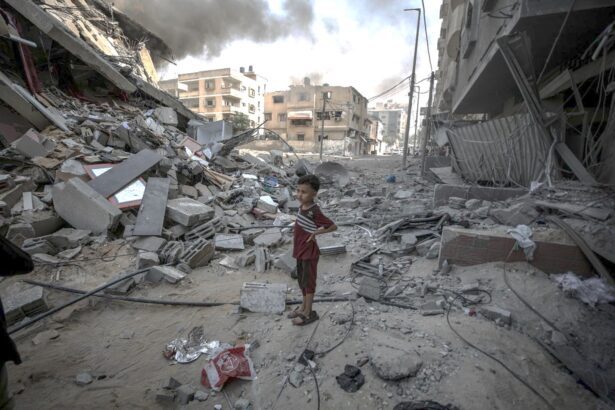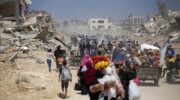The little town of Bethlehem is quiet this Christmas, as more and more deaths are reported in Gaza. An Israeli former hostage discusses her captivity.

Gaza’s health ministry said that dozens of Palestinians were publicly “executed” during an Israeli military operation in the northern town of Jabaliya this week, and has testimonies showing “the Israeli army carried out the summary execution of 137 Palestinian civilians” in the northern Gaza Strip. The Israeli army claims it is ‘unaware’ of civilian execution accusations.
Euro-Med Human Rights Monitor stated that “it had received horrifying testimony regarding killings and field executions of several people over the age of 60. These incidents included soldiers shooting elderly people immediately after ordering them to evacuate their homes, and in some cases, executing them just moments after their release from hours or days of arbitrary detention.”
Palestine Chronicle reports: “Our guards in Gaza protected us from bombing with their bodies, respected women,” says former Israeli captive: In an interview on Israeli television, Chen Almog Goldstein said that “The guards who held us (in Gaza) were protecting us with their bodies from the bombing. When we asked them if they were going to kill us, their response was: we will die before you die.”
Goldstein noted that the guards “were very close to us, and we did not stay alone for a moment. Therefore, I was afraid that the (Israeli) army would come at any moment. I was afraid of that. They respected women. To them, women are sacred and they are not allowed to touch them. To them, women are queens.” The prisoner also spoke about her two young sons, saying, “They were playing and drawing, and our guards even taught them some card games.”
TRT World reports:
“[Prime Minister Benjamin] Netanyahu wanted to overthrow Hamas, but if our forces killed the two Hamas guards who were with me, what would become of me?” her daughter Agam said.
“We have received answers for such questions here in Israel. Without our captors, we would have been killed by the fire of our own forces.”
The Israeli army said on December 15 that its forces had mistakenly killed three Israeli hostages in northern Gaza. Nearly 130 Israeli hostages are believed to be still held by Hamas and other Palestinian factions in Gaza.
A New York Times piece from December 15th, entitled Apology, Tears and Terror: A Former Hostage Recounts a 7-Week Ordeal, provides a fuller picture of Chen Almog Goldstein’s experience:
The strangest part of her seven-week ordeal, said Chen Goldstein-Almog, formerly an Israeli hostage of Hamas, were the long, almost intimate conversations she had with her captors.
They talked about their families, their lives and the extreme danger they all faced.
One of the gunmen holding her even apologized for the killing of her husband and one of her daughters by other Hamas gunmen, she said.
“It was a mistake and against the Quran,” he told her, Ms. Goldstein-Almog remembered.
She said a long silence followed, and the room she and three of her children were being held in immediately filled with tension.
“I didn’t respond,” she said. She was distraught about their deaths, but at that moment, she said, “I didn’t feel I could express any negative feelings.”
Ms. Goldstein-Almog, 48, and the three children were kidnapped on Oct. 7 from the Kfar Aza kibbutz, near the border of Gaza and one of the worst hit during the Hamas terrorist attacks. Her husband and eldest daughter were killed.
She and the surviving children — another daughter, Agam, 17, and two sons, Gal, 11, and Tal, 9 — were released in late November as part of the exchange of prisoners between Israel and Hamas that has since ceased.
In an interview this week, she shared details about her ordeal.
She said she and the children were held together, treated “respectfully” and not physically harmed. But she said that over the course of various moves during their captivity, she had met other hostages who were badly treated, including two women who said they were sexually abused.
Mostly, they were held in a room in an apartment in Gaza, she said, with the windows closed except for a bit of fresh air in the early mornings. But the heavily armed captors also moved Ms. Goldstein-Almog and her children to different apartments, tunnels, a mosque, even a destroyed supermarket, she said.
With the Israeli military pounding Gaza, each transfer was terrifying, and the men holding them, she said, didn’t always seem to know what to do.
Describing one move, she said: “It was the middle of the night. Everything was dark. They started deliberating among themselves. I could see the helplessness on their faces.”
“When we were out into the street, in total darkness, there was a shot above us,” she continued. “We were pressed against the wall, and I could see a laser pointer, as if we were being targeted from above.”
And she was thinking: That’s our air force up there.
“It was crazy,” she said, “this absurdity.”
Her conversations with her guards sometimes went on for hours, she said, maybe because she was once a social worker and knew how to keep someone in a long, deep conversation — her only way of trying to make sure, she said, that she and the children would be safe.
The guards taught her son Gal 250 words in Arabic to keep him occupied and brought him a notebook to study. She said the family and the guards regularly discussed what to eat. Most days they survived off pita bread with cheese, usually feta. In the early days there were also a few vegetables. She said the guards told her they were members of Hamas.
The lead guard seemed educated and spoke Hebrew, she said. In the apartment where they stayed the longest, he sometimes invited the family to join in cooking in the kitchen, though even in these moments, the guards carried pistols. The guards would escort them to the bathroom on request, and allowed them to sleep.
Each member of the family had emotional ups and downs. Sometimes they would talk about what happened on Oct. 7, or would realize no cease-fire was near. The captors didn’t like it when the children cried, she said. They asked immediately for them to stop.
“And if for a moment, I would sit and sink in my thoughts,” she said, the lead captor “would directly ask me what I was thinking. I couldn’t move from room to room without an armed guard accompanying me. Once, my two sons were arguing, and the guard raised his voice at one of them, which was scary.”
There were even moments when the guards cried in front of them, she said, worried about their own families.
“We were in daily danger,” she said. “It was fear at a level we didn’t know existed.”
She couldn’t stop replaying the death of her husband, Nadav, 48, whom she started dating in high school and who was killed in front of their eyes along with their oldest daughter, Yam, 20, a soldier just two months from the end of her service.
At the end of their captivity, the lead guard turned to Ms. Goldstein-Almog and gave her a warning: Don’t go back to your kibbutz, he said. Don’t return to a place so close to Gaza. Go to Tel Aviv or somewhere farther north, she remembers him saying. Because we are coming back.
Ms. Goldstein-Almog’s response?
“Next time you come,” she said she told them, “don’t throw a grenade. Just knock on the door.”
The family has several military connections: the daughter who was killed was a sergeant in the IDF, and another relative is a former head of the Southern Command.
The kibbutz is part of the so-called Gaza Envelope, the Israeli kibbutz settlements that surround Gaza, which are built on stolen land. About 80 percent of Gaza’s population are families that Israel violently expelled, then has kept caged in one small corner of their original lands for over 75 years.
[This article has been updated from the original post that included only the Palestine Chronicle account.]

STATISTICS OCTOBER 7 – DECEMBER 23:
Palestinian death toll since October 7: at least 20,090* (~19,953 in Gaza* (over 8,663 children), and at least 303 in the West Bank). This does not include an estimated 8,000 more still buried under rubble. Euro-Med Monitor reports 27,137 Palestinian deaths.
*IAK does not yet include 471 Gazans killed in the Al Ahli hospital blast since the source of the projectile is being disputed; although much evidence points to Israel as the culprit, experts are still looking into the incident. Israel is blocking an international investigation.
Palestinian injuries since October 7: at least 58,665** (including at least 55,000 in Gaza** and 3,665 in the West Bank). **NOTE: it is impossible to provide an accurate number of injuries in Gaza due to the ongoing bombardment and communication disruption.
It remains unknown how many Americans are among the casualties. in Gaza**. About 1.9 million people have been displaced (about 85-90% of the population).
Reported Israeli death toll since October 7: ~1,139 (7 killed in West Bank, 152 in Gaza), including 32 Americans, and 5,431 injured, approximately 36 children).
NOTE: It is unknown at this time how many of the deaths and injuries in Israel may have been caused by Israeli soldiers; additionally, since Israel has a policy of universal conscription, it is unknown how many of those attending the outdoor rave a few miles from Gaza on stolen Palestinian land were Israeli soldiers.
Find previous daily casualty figures and daily news updates here. For more news, go here and here. Live broadcast news from the region is here.
Source: IsraelPalestineTimeline.org
- 12 Essential Facts for Understanding the Current Israel-Gaza Violence
- Israel’s Assault on Gaza Is Unlike Any War in Recent Memory
- US poised to give Israel $18 billion in aid this year
- Remembering Lubna Alyaan, the aspiring violinist killed in Gaza
- Rumors of war: did hundreds of Hamas fighters surrender to Israeli forces?
- Gaza Civilians, Under Israeli Barrage, Are Being Killed at Historic Pace
- Israel has lost control of the narrative – October 7 truths coming out
- Essential facts and stats about the Hamas-Gaza-Israel war
- What media reports fail to tell you about October 7





